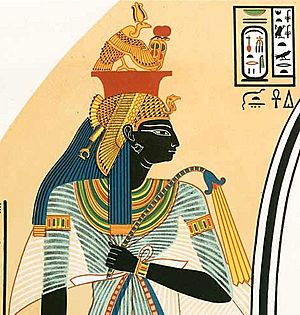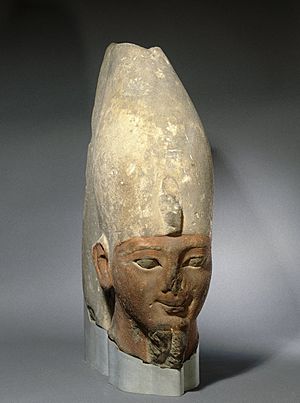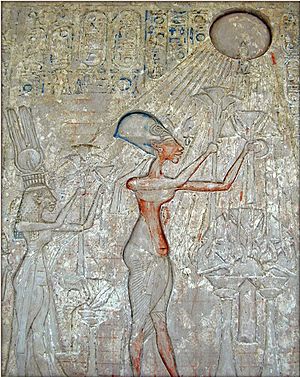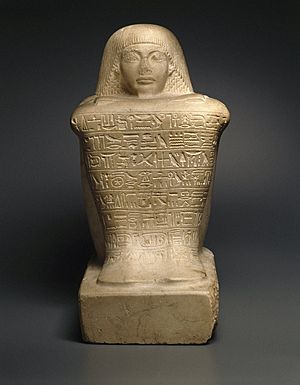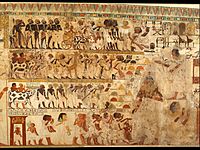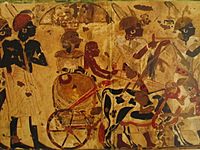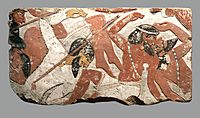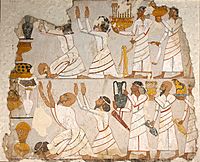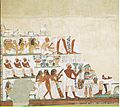Eighteenth Dynasty of Egypt facts for kids
Quick facts for kids
Eighteenth Dynasty of Egypt
|
|||||||||||
|---|---|---|---|---|---|---|---|---|---|---|---|
| c. 1550 BCE–1292 BCE | |||||||||||

The Egyptian Eighteenth Dynasty's empire at its greatest territorial extent under Thutmose III
|
|||||||||||
| Capital | Thebes, Akhetaten | ||||||||||
| Common languages | Middle Egyptian (to c. 1350 BCE) Late Egyptian (from c. 1350 BCE) Canaanite languages Nubian languages Akkadian (diplomatic and trade language) |
||||||||||
| Religion | Ancient Egyptian religion Atenism |
||||||||||
| Government | Absolute monarchy | ||||||||||
| Historical era | Bronze Age | ||||||||||
|
• Defeat of the Fifteenth Dynasty (expulsion of the Hyksos)
|
c. 1550 BCE | ||||||||||
| c. 1457 BCE | |||||||||||
| c. 1350–1330 BCE | |||||||||||
|
• Death of Horemheb
|
1292 BCE | ||||||||||
|
|||||||||||
The Eighteenth Dynasty of Egypt was the first dynasty of the New Kingdom of Egypt. This was a time when ancient Egypt was at its most powerful. This dynasty lasted from about 1550 BC to 1292 BC. It is also called the Thutmosid Dynasty because four pharaohs were named Thutmose.
Many of Egypt's most famous pharaohs came from this dynasty. These include Tutankhamun, whose amazing tomb was found in 1922. Other famous rulers were Hatshepsut, a powerful woman pharaoh, and Akhenaten, known for his new ideas about religion. His wife, Nefertiti, was also very famous.
The Eighteenth Dynasty was special because two women ruled as pharaohs on their own. These were Hatshepsut, who was very creative, and Neferneferuaten, who is often thought to be Nefertiti.
Contents
History of the Eighteenth Dynasty
Early Rulers
The Eighteenth Dynasty started with Ahmose I. He was the brother or son of Kamose, the last ruler of the 17th Dynasty. Ahmose I finished pushing out the Hyksos rulers from Egypt. His rule marked the end of a difficult time and the start of the New Kingdom.
Ahmose's wife, Queen Ahmose-Nefertari, was a very respected woman in Egyptian history. She was even seen as a goddess after she died. Ahmose was followed by his son, Amenhotep I. His time as pharaoh was quite peaceful.
Amenhotep I likely had no sons to take over. So, the next pharaoh, Thutmose I, became ruler through marriage to a royal family member. During his reign, Egypt's empire grew very large. It stretched far north to Carchemish and south beyond the fourth cataract of the Nile.
Thutmose I was followed by Thutmose II and his queen, Hatshepsut. Hatshepsut was the daughter of Thutmose I. After her husband died, she ruled for her young stepson, who would become Thutmose III. But soon, Hatshepsut became pharaoh herself and ruled for over twenty years.
Thutmose III became known as one of Egypt's greatest military pharaohs. He also ruled for a long time. Later in his life, he shared power with his son, Amenhotep II. Amenhotep II was followed by Thutmose IV, who was then followed by his son, Amenhotep III. Amenhotep III's reign was a very successful time for the dynasty.
Amenhotep III's rule was a time of great wealth and beautiful art. Egypt was very powerful internationally. More than 250 statues of him have been found. He also built many large buildings, like the ones built by Ramesses II later on. Amenhotep III's main wife was Tiye. He even built an artificial lake for her.
Akhenaten, the Amarna Period, and Tutankhamun

Amenhotep III might have shared his throne with his son, Amenhotep IV, for some years. Experts still discuss how long this shared rule lasted, or if it happened at all.
In his fifth year, Amenhotep IV changed his name to Akhenaten. This name means "Effective for the Aten". He moved his capital city to Amarna, which he called Akhetaten. During Akhenaten's rule, the Aten (the sun disk) became the most important god. Eventually, it was seen as the only god. This was a big change from the many gods Egyptians usually worshipped.
Later Egyptians thought this "Amarna Period" was a mistake. After Akhenaten died, two pharaohs, Smenkhkare and Neferneferuaten, ruled for a short time. Not much is known about them. In 1334 BC, Akhenaten's son, Tutankhaten, became pharaoh. Soon after, he brought back the old Egyptian religion with many gods. He changed his name to Tutankhamun to honor the god Amun. His young daughters were the last family members of the Eighteenth Dynasty.
Ay and Horemheb
The last two pharaohs of the Eighteenth Dynasty were Ay and Horemheb. They were high-ranking officials in the royal court before becoming rulers. Ay might have been Akhenaten's uncle.
Ay may have married Ankhesenamun, Tutankhamun's widowed wife, to gain power. She died soon after. Ay then married Tey.
Ay's rule was short. His successor was Horemheb, a general during Tutankhamun's time. Horemheb might have taken the throne from Ay. Ay's son, Nakhtmin, was supposed to be the next ruler. But Nakhtmin seems to have died during Ay's reign. This allowed Horemheb to become pharaoh.
Horemheb also died without children. He chose his chief minister, Pa-ra-mes-su, as his heir. This minister became Ramesses I in 1292 BC. He was the first pharaoh of the Nineteenth Dynasty.
Egypt's Relations with Other Lands
Relations with Nubia
The Eighteenth Dynasty empire took control of all of Lower Nubia under Thutmose I. By the time of Thutmose III, Egyptians directly controlled Nubia up to the fourth cataract of the Nile River. Egyptian influence also reached even further south. The Egyptians called this area Kush. It was managed by an official called the Viceroy of Kush.
The 18th dynasty got gold, animal skins, ivory, and good quality cattle and horses from Nubia. Egyptians built temples all over Nubia. One important temple was for the god Amun at Jebel Barkal. This temple was made bigger by later Egyptian and Nubian pharaohs.
-
Nubian Prince Heqanefer bringing gifts for King Tutankhamun.
-
Nubians bringing gifts for King Tutankhamun.
Relations with the Near-East
After the Hyksos rulers left, the Eighteenth Dynasty expanded its power. They conquered large areas of the Near East. Pharaoh Thutmose III especially defeated groups like the "Shasu" Bedouins and the land of Retjenu. He also reached as far as Syria and Mitanni in many military campaigns around 1450 BC.
Dating the Dynasty
Scientists use Radiocarbon dating to figure out old dates. This method suggests that the 18th Dynasty might have started a few years earlier than the usual date of 1550 BC. It could have begun between 1570 BC and 1544 BC.
Pharaohs of the 18th Dynasty
The pharaohs of Dynasty XVIII ruled for about 250 years. Many of them were buried in the Valley of the Kings in Thebes. Sometimes, pharaohs married daughters of foreign kings to keep good relations between countries.
| Pharaoh | Image | Throne name / Prenomen | Reign | Burial | Consort(s) | Comments |
|---|---|---|---|---|---|---|
| Ahmose I / Ahmosis I | Nebpehtire | 1549–1524 BC | Ahmose-Nefertari Ahmose-Henuttamehu Ahmose-Sitkamose |
|||
| Amenhotep I | 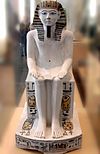 |
Djeserkare | 1524–1503 BC | KV39? or Tomb ANB? | Ahmose-Meritamon | |
| Thutmose I | 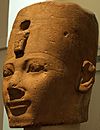 |
Aakheperkare | 1503–1493 BC | KV20, KV38 | Ahmose Mutnofret |
|
| Thutmose II |  |
Aakheperenre | 1493–1479 BC | KV42? | Hatshepsut Iset |
|
| Hatshepsut |  |
Maatkare | 1479–1458 BC | KV20 | Thutmose II | |
| Thutmose III | 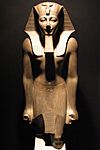 |
Menkheper(en)re | 1479–1425 BC | KV34 | Satiah Merytre-Hatshepsut Nebtu Menhet, Menwi and Merti |
|
| Amenhotep II | 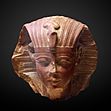 |
Aakheperure | 1427–1397 BC | KV35 | Tiaa | |
| Thutmose IV |  |
Menkheperure | 1397–1388 BC | KV43 | Nefertari Iaret Mutemwiya Daughter of Artatama I of Mitanni |
|
| Amenhotep III | 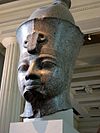 |
Nebmaatre | 1388–1351 BC | KV22 | Tiye Gilukhipa of Mitanni Tadukhipa of Mitanni Sitamun Iset Daughter of Kurigalzu I of Babylon Daughter of Kadashman-Enlil of Babylon Daughter of Tarhundaradu of Arzawa Daughter of the ruler of Ammia |
|
| Amenhotep IV/Akhenaten | 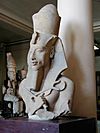 |
Neferkepherure-Waenre | 1351–1334 BC | Royal Tomb of Akhenaten | Nefertiti Kiya Tadukhipa of Mitanni Daughter of Šatiya, ruler of Enišasi Meritaten? Meketaten? Ankhesenamun Daughter of Burna-Buriash II, King of Babylon |
|
| Smenkhkare | 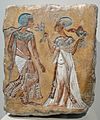 |
Ankhkheperure | 1335–1334 BC | Meritaten | ||
| Neferneferuaten | 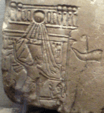 |
Ankhkheperure-Akhet-en-hyes | 1334–1332 BC | Akhenaten? Smenkhkare? |
Usually identified as Queen Nefertiti | |
| Tutankhamun | 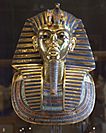 |
Nebkheperure | 1332–1323 BC | KV62 | Ankhesenamun | |
| Ay | 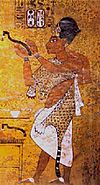 |
Kheperkheperure | 1323–1319 BC | KV23 | Ankhesenamun Tey |
|
| Horemheb | 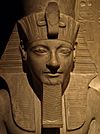 |
Djeserkheperure-Setepenre | 1319–1292 BC | KV57 | Mutnedjmet Amenia |
Timeline of the 18th Dynasty

Images for kids
-
Ahmose I united Egypt again.
-
Amenhotep I became pharaoh after his brothers died.
-
Thutmose I expanded Egypt's borders and started building projects at Karnak.
-
Sketch of Thutmose II. He was married to Hatshepsut.
-
Amenhotep III ruled during a time of great wealth.
-
Akhenaten changed Egypt's religion to worship the Aten.
-
Nefertiti, wife of Akhenaten, may have ruled as pharaoh herself.
-
Meritaten, eldest daughter of Akhenaten and Nefertiti.
-
Tutankhamun brought back the old Egyptian religion.
-
Horemheb was a general who became pharaoh and restored order.
See also
 In Spanish: Dinastía XVIII de Egipto para niños
In Spanish: Dinastía XVIII de Egipto para niños


